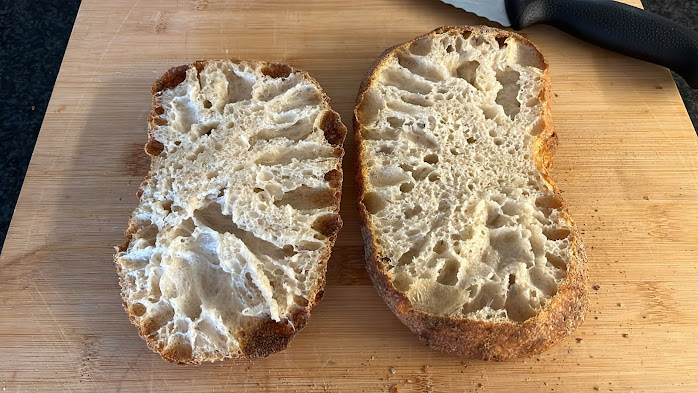
Welcome to another step-by-step recipe from BreadClub20. Why not drop by our main Facebook page by clicking here... . If you like what you see and enjoy the recipe, we hope you join us by 'Liking' and 'Subscribing'.
This is a long-ferment ciabatta broken down into several stages.
Making the preferment.
In a bowl:
240 gms strong bread flour
1 gms instant yeast
130 gms tepid water.
Mix together and then knead for 5 minutes.
Tear the dough up into small pieces and return to the bowl.
Cover and leave at room temperature for 48 hours at 20⁰C. It should at least double in that time. It will also smell quite yeasty and have gluten strings underneath when gently pulled.

After 24 hours......
 |
| After 40 hours+ and nicely fermented. |
Bring the dough together into a ball and transfer to a clean bowl
Now, in the first bowl, add
25 gms bread flour,
5 gms crushed sea salt
70 gms tepid water
and stir until well combined.
Pout over the fermented dough in the clean bowl and mix thoroughly by squeezing and mixing with the fingers.
Knead for about 10 minutes until all the flour/salt/water mixture is absorbed into the dough.
Cover and place in the refrigerator for 15 minutes.
Wet your hands.
Remove the dough from the refrigerator, stretch it gently upwards and then fold it back over. Stretch north, south, east and west.
Now, pick up the dough and throw it back into the bowl, then pull and fold.
Keep picking it up, throwing it back into the bowl, stretching and folding.
Repeat this 12 times.
Recover and place back in the refrigerator for 15 minutes.
Repeat this stretch, fold, beat, stretch, fold process, and chill for the second time. (Try not to tear the dough).
Repeat the stretch, fold, beat, stretch, fold process, and chill for the third time. (Try not to tear the dough).
Oil a shallow dish (a food container is ideal if it's big enough to take the dough).
Place it in the oiled container. Cover and place in a warm place for about an hour. (Warm should be as near to 30⁰C as you can achieve)
After one hour, complete a final series of stretches and folds. This time, don't beat the dough.
Cover and return it to the warm place of Stage 3 and leave for another hour.
Prepare a sheet of parchment and flour it generously. Rice or semolina flours are ideal.
Flour the top of the dough and gently invert it onto the parchment paper. A void shaking the container....allow gravity to do the work for you.
Dust the dough with flour and, using a scraper, tidy up the edges, divide the dough into two and flour the raw edges. Gently separate the pieces, and flour again.
Cover and leave at room temperature for 1 hour.
Preheat the oven to 240⁰C.
Mist the oven with water.
Gently transfer the parchment paper and dough pieces to a baking sheet. Cover with another piece of parchment paper and bake for 10 minutes.
After 10 minutes remove the top sheet of parchment paper.
Continue to bake for 15 - 20 minutes until golden brown and hollow when tapped underneath.
Cool on a rack.
NB - if your proofing temperature is lower than 30⁰C make a suitable allowance for the time and extend the process.






















Comments
Post a Comment